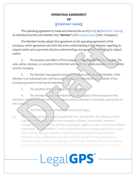What to Do When a Vendor Breaches Their Contract
You’ve planned a major product launch for your online store, counting on a vendor to deliver 500 units of inventory by Friday. But Friday comes, and...
7 min read
LegalGPS : May. 15, 2025
You open an email from a customer, expecting a routine inquiry, only to find a chilling message: “I’m consulting a lawyer,” or worse, “You’ll hear from my attorney.” Your stomach drops. Legal threats from customers can feel like a personal attack on your business, sparking fears of lawsuits, financial loss, or reputational damage. Whether it’s a dissatisfied client, a product issue, or a misunderstanding, these threats are a reality for small business owners, freelancers, and entrepreneurs.


Legal GPS Pro
Protect your business with our complete legal subscription service, designed by top startup attorneys.
The good news? You can navigate this situation with confidence and protect your business. This guide provides a step-by-step, actionable plan to handle a customer’s legal threat, from staying calm to preparing for potential litigation. Packed with real-world examples and practical Pro Tips, you’ll learn how to de-escalate disputes, resolve issues, and prevent future threats. Let’s turn this challenge into an opportunity to strengthen your business.
A customer’s legal threat can trigger panic, but staying calm is your first defense. A clear head lets you evaluate the situation objectively and respond strategically.
Resist the urge to fire back defensively or ignore the threat. Both can escalate the situation or weaken your position later.
Analyze the customer’s issue. Ask:
This clarity shapes your response.

Settlement and Release Agreement
Learn about Settlement and Release Agreements including key components and how to write one. Ensure clarity and closure in resolving disputes with this legal contract.
Trusted by 1,000+ businesses to safeguard their LLCs.
Review any agreements with the customer for:
A strong contract can defuse unfounded claims.
Gather all relevant records:
Organize these chronologically to build a clear timeline.
Sarah, a small retailer, received a legal threat from a customer claiming a $500 appliance broke after one use. Sarah reviewed the sales receipt, which noted a 30-day return policy, and emails showing the customer’s delayed complaint (45 days post-purchase). She also saved photos of the product’s condition at sale. This documentation helped her assess the claim’s validity and prepare a response.
Create a dispute folder for each customer issue:
Having this ready streamlines negotiations or legal defenses. Explore our contract templates for agreements that clarify terms and reduce disputes.
A professional response can de-escalate a legal threat and show you’re taking the customer seriously, often resolving the issue without further conflict.
Send a polite email or letter within 1–3 days. Key elements:
Example: “Thank you for your email. I’m sorry to hear about your concerns and would like to work toward a solution.”
Ask for specifics to clarify the claim:
This shows good faith and helps you assess their case.
Use a calm, solution-focused tone. Avoid arguing or dismissing their concerns, as this can escalate the situation or be used against you later.
Mark, a freelance graphic designer, received a legal threat from a client claiming a $2,000 logo project was “unusable.” Mark sent a polite email acknowledging the concern, asking for specific feedback, and offering to revise the designs. The client clarified their issue, Mark made adjustments, and the threat was dropped, preserving the relationship.
Your response should include:
Keep a copy of the letter.
Many legal threats can be resolved without litigation through proactive solutions or negotiation.
Propose remedies based on the customer’s complaint:


Legal GPS Pro
Protect your business with our complete legal subscription service, designed by top startup attorneys.
If the customer demands more, negotiate a compromise:
If negotiations stall, suggest mediation through a local dispute resolution center. A neutral mediator facilitates a fair agreement, typically costing $100–$500, split between parties.
Lisa, a restaurant owner, faced a legal threat from a customer claiming food poisoning after a $200 catering order. Lisa offered a full refund and a $100 gift card, documented in a signed agreement. The customer accepted, avoiding a costly lawsuit and preserving the restaurant’s reputation.
Keep discussions productive with:
If the threat escalates or involves significant claims, legal advice is critical to protect your business.
Hire a lawyer specializing in small business or contract law. They can:
Many offer free initial consultations.
Check your business liability insurance for coverage of:
Once you involve a lawyer, direct all customer communication through them. Avoid discussing the issue directly to prevent missteps.
Tom, a boutique owner, received a legal threat over a $1,500 dress allegedly damaged during alteration. His attorney reviewed the contract, which disclaimed liability for custom work, and sent a letter denying the claim. The customer dropped the threat, and Tom’s insurance covered the legal fees.
To locate a lawyer:
If the customer files a lawsuit, preparation is key to a strong defense.
Organize all documentation:
Research the customer’s legal grounds, such as:
This helps you anticipate their arguments.
Rachel, a contractor, was sued in small claims court for $5,000 by a customer claiming incomplete renovations. Rachel presented her contract, photos of completed work, and emails showing customer approvals. The judge dismissed the case, citing insufficient evidence from the customer.
To get ready:
Proactive measures can reduce the risk of customer legal threats.
Include:
Set expectations upfront:
Equip your team to handle complaints:
Emily, an online retailer, faced frequent legal threats over shipping delays. She updated her contracts with clear delivery timelines, trained staff to handle complaints proactively, and added a FAQ page explaining policies. Complaints dropped by 70% within six months.
Implement these practices:
A customer’s legal threat can feel overwhelming, but you have the tools to respond with confidence. By staying calm, responding professionally, exploring resolutions, consulting legal advice, preparing for litigation, and preventing future threats, you can protect your business and reputation. These steps turn a potential crisis into an opportunity to strengthen your operations.
Don’t let legal threats derail your success. Visit our legal resources for contract templates and dispute resolution guides tailored to small businesses and freelancers. Take control of customer disputes and keep your business thriving.
The biggest question now is, "Do you need a lawyer for your business?” For most businesses and in most cases, you don't need a lawyer to start your business. Instead, many business owners rely on Legal GPS Pro to help with legal issues.
Legal GPS Pro is your All-In-One Legal Toolkit for Businesses. Developed by top startup attorneys, Pro gives you access to 100+ expertly crafted templates including operating agreements, NDAs, and service agreements, and an interactive platform. All designed to protect your company and set it up for lasting success.

Legal GPS Pro
Protect your business with our complete legal subscription service, designed by top startup attorneys.
|
Premium Template
Single-use Template |
Legal GPS Pro
Unlimited Access, Best Value |
|
|
| Choose Template | Learn More |
| Trusted by 1000+ businesses | |

You’ve planned a major product launch for your online store, counting on a vendor to deliver 500 units of inventory by Friday. But Friday comes, and...

Your online store is gearing up for a Black Friday sale, with hundreds of orders banking on a supplier delivering 1,000 units of your best-selling...

You’ve hired a contractor, agreed on a timeline, and planned your project around their promised completion date. But as the deadline approaches, the...